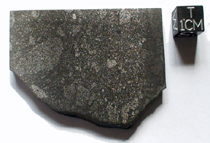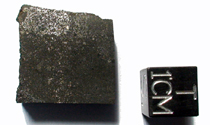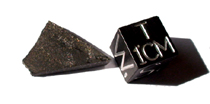E Group
The chondrites of this group are named for their primary mineral,
enstatite, and they differ in many respects from ordinary and carbonaceous
chondrites. They must have formed in an oxygen-depleted environment
because nearly all of the iron in E chondrites is present in its reduced,
metallic form. Even the pyroxene is depleted in iron, and consequently, it
is only found as the pure magnesium-rich end-member - enstatite. After
taking into consideration all of the possible pairings among the
meteorites recovered in the strewn fields of Africa and in Antarctica,
approximately 90 different E chondrites have been identified.
Similar to the ordinary chondrites, the enstatite chondrites have been
further subdivided based on their content of total iron; members of the EL
group contain less iron than members of the EH group. Moreover, there are
mineralogical aspects that separate the two groups. The EL chondrites show
petrologic types 3 to 7, and there is a distinct peak at the equilibrated
type 6. The members of the EH subgroup exhibit petrologic types from 3 to
6 with a less distinct peak at the unequilibrated type 3.
Despite the differences, most researchers believe that both subgroups
originated on the same asteroid, most probably representing different
layers of the parent body. Some scientists think that we should look for
this asteroid inside the orbit of Venus or even Mercury since the E
chondrites formed under highly reducing conditions in an oxygen-depleted
environment. Other researchers suggest that a formation in the inner
asteroid belt would have provided the same conditions in the early solar
system. A more recent comparison of the reflectance spectra of different
asteroids to the spectrum of the EH chondrite Abee suggests that the main
belt asteroid 16 Psyche might be the common parent for the enstatite
chondrites.
|
Abee
EH4 IMB
The Abee meteorite fell at 11:05 p.m. on June 9th, 1952
Country: Alberta, Canada
A stone of 107 kg was recovered from 6 ft deep crater
|
|
|
 
|
|
|
|
Abee 00
38.21 gr
Very nice slice with crust on the edge
Price
on request
|
|
|
|
|
|
|
|
Abee 01
6.87 gr
Nice slice with patch of crust on the edge
SOLD
|
|
|
|
 
|
|
|
|
|
|
|
 
|
|
|
|
Abee 02
1.24 gr
Small triangular slice of Abee !
SOLD
|
|
|
|
|
|
|
|